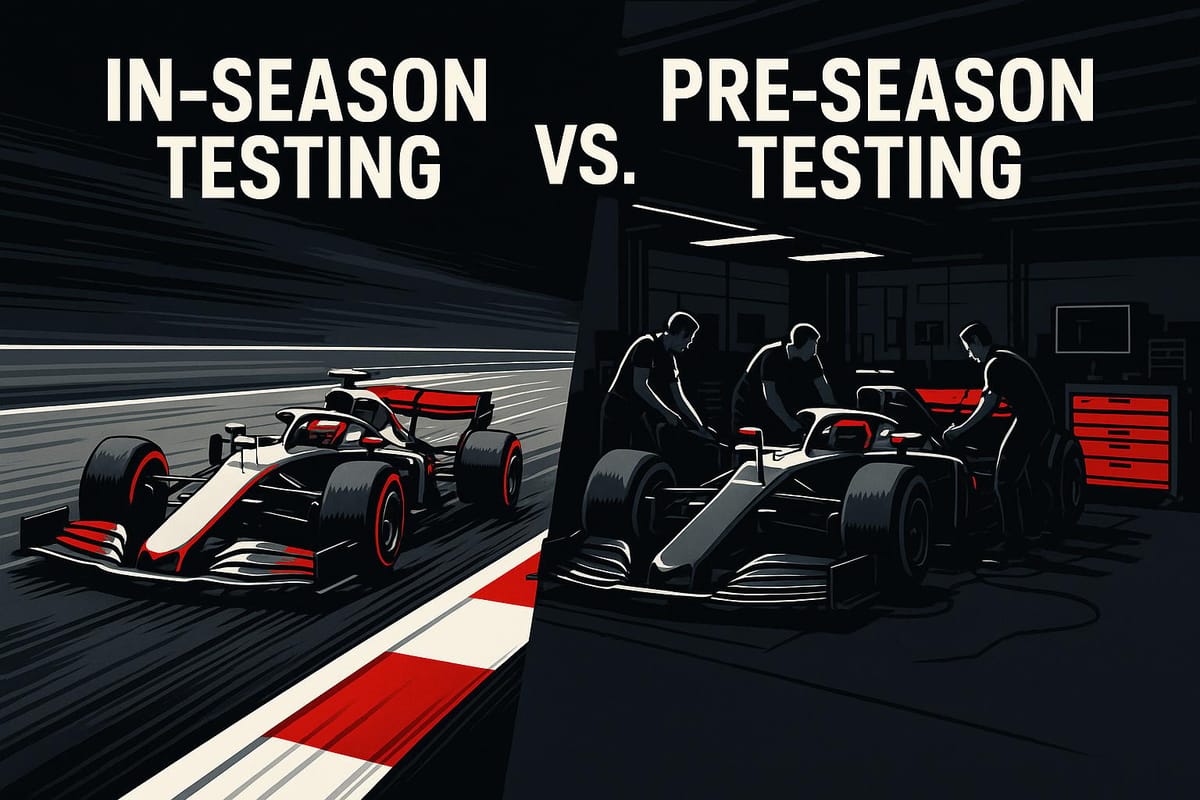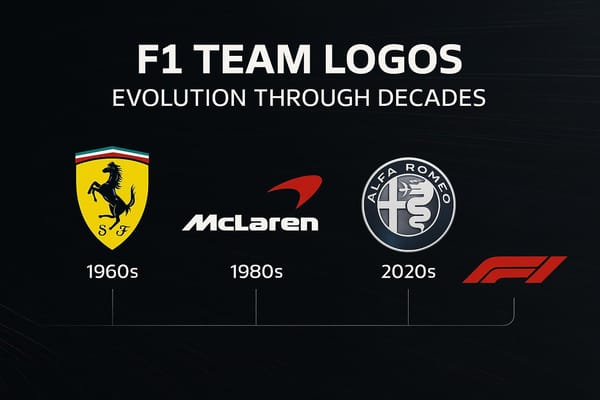In-Season Testing vs. Pre-Season Testing
Explore the critical differences between pre-season and in-season testing in F1, highlighting their unique purposes and impact on team performance.

F1 testing is the backbone of car performance and reliability. Teams use two key phases to prepare and refine their cars: pre-season testing and in-season testing. Both serve distinct purposes but are critical for success on the track.
- Pre-Season Testing: Held before the season starts, it focuses on system reliability, baseline performance, and aerodynamic checks over 24 hours of track time (3 days). Teams gather data to validate new car designs and catch early issues.
- In-Season Testing: Conducted during the season, it targets specific improvements like aerodynamic upgrades, solving reliability issues, and refining setups for upcoming races. These sessions are shorter and more focused.
Quick Comparison
| Aspect | Pre-Season Testing | In-Season Testing |
|---|---|---|
| Purpose | Establish baseline performance | Fine-tune upgrades and solve issues |
| Duration | 24 hours over 3 days | Limited, between race weekends |
| Focus | Broad system checks | Targeted problem-solving |
| Weather Impact | Can affect data quality | More representative conditions |
| Driver Role | Familiarize with car | Test upgrades and setups |
Bottom Line: Pre-season testing sets the foundation, while in-season testing fine-tunes performance. Together, they help teams stay competitive throughout the F1 calendar.
Testing Goals: Pre-Season vs In-Season
Pre-Season Testing Focus
Pre-season testing is all about putting new car designs through their paces. Over a three-day, 24-hour testing window, teams focus on system reliability, aerodynamic performance, and setting baseline configurations. This includes scrutinizing critical systems like cooling, hydraulics, and electronics to ensure every component performs as expected. Modern race cars churn out up to 90MB of lap data, which is crucial for verifying off-season developments. The first day typically revolves around essential system checks, giving teams a chance to catch and address any early reliability hiccups.
In-Season Testing Focus
Once the season is underway, testing shifts gears. These sessions become opportunities to:
- Fine-tune aerodynamic and mechanical upgrades
- Solve reliability issues that surface during races
- Adjust car setups for upcoming circuits
- Experiment with new tire compounds
- Compare simulator predictions with real-world performance
While pre-season testing lays the groundwork, in-season testing zeroes in on refining performance and tackling challenges as they arise.
Common Testing Elements
Even though pre-season and in-season testing have different priorities, they share several core activities:
| Testing Element | Pre-Season Application | In-Season Application |
|---|---|---|
| Data Collection | Gathering baseline performance data | Focusing on data for specific upgrades |
| Tire Testing | Evaluating tire compounds initially | Optimizing tires for particular track conditions |
| Driver Feedback | Familiarizing with the car | Assessing upgrades and setup tweaks |
| Simulator Correlation | Initial validation of simulator models | Refining and aligning simulator data |
| Setup Work | Establishing a baseline | Tailoring setups for specific tracks |
Driver feedback remains a cornerstone in both phases, complementing the wealth of sensor data. Drivers provide insights into handling and performance quirks that numbers alone can’t capture. As track time becomes more limited, teams increasingly lean on advanced simulators, reserving on-track sessions for final validations.
Testing Rules and Organization
Test Duration and Scheduling
Modern Formula 1 testing operates under a tightly regulated schedule to keep costs in check and ensure fairness among teams. Pre-season testing is limited to just three days, with daily sessions running from 10:00 AM to 7:00 PM local time. This includes a one-hour break, giving each team a total of 24 hours of track time over the three days. In-season testing is even more restricted, with sessions scheduled on specific days during the racing calendar - typically right after Grand Prix weekends to streamline logistics. This precise timing allows teams to quickly apply any insights gained to their race strategies.
Test Track Selection
The Bahrain International Circuit is the go-to venue for pre-season testing. Its dependable weather, state-of-the-art facilities, and variety of corner types make it an ideal location for evaluating car performance. In-season testing, on the other hand, takes place at active Grand Prix circuits. This approach minimizes transportation costs while utilizing familiar track setups, making it easier for teams to validate performance and refine strategies.
Testing Rules and Limits
Formula 1 testing is governed by strict regulations that influence how teams approach each session. The table below highlights some of the key parameters:
| Aspect | Pre-Season Testing | In-Season Testing |
|---|---|---|
| Car Usage | Teams can only use one car | Same single-car rule applies |
| Driver Eligibility | Regular race drivers are allowed | Primarily for young or reserve drivers |
| Data Collection | Advanced sensors collect extensive data | Standard race weekend setups are used |
| Component Limits | Parts and tires are tightly regulated | Even stricter component restrictions |
| Personnel | Full team attendance is permitted | Fewer trackside staff allowed |
With pre-season testing reduced from over 10 days to just three, teams now depend heavily on advanced simulations and carefully planned on-track sessions. These regulations force teams to prioritize their objectives - whether it's testing new parts, fine-tuning setups, or giving reserve drivers valuable track time. Every moment on the circuit counts, making efficiency and precision critical.
Team Resources and Planning
Pre-Season Team Setup
Pre-season testing is all about making the most of limited track time, and that means mobilizing every resource available. Teams bring their top engineers and cutting-edge equipment to a single venue, ensuring they extract as much data as possible. Key team roles during this phase include:
- Track-Side Engineers: Handle real-time data analysis and make on-the-spot setup adjustments.
- Systems Engineers: Keep a close eye on car reliability and monitor how components perform.
- Aerodynamicists: Fine-tune and evaluate the car's aerodynamic behavior.
- Data Analysts: Process vast amounts of sensor data to uncover insights.
Take Mercedes as an example - they run parallel simulations during pre-season testing to maximize the data they collect. While pre-season testing involves the entire team working in unison, the in-season approach requires a more specialized division of labor.
In-Season Work Balance
Once the season kicks off, teams face the tricky task of juggling race-day performance with ongoing development and limited testing opportunities. Most engineering staff focus on getting the best results during race weekends. Meanwhile, smaller specialized groups work on designing future upgrades and performing targeted tests. Red Bull is a standout here, leveraging rapid prototyping and carefully chosen in-season tests to validate new upgrades quickly.
Budget Cap Effects
The introduction of Formula 1's budget cap has added another layer of complexity to resource planning. Teams now have to think strategically about how they allocate funds and manpower. This often involves:
- Investing in Simulations: Advanced simulation tools help reduce reliance on physical testing.
- Optimizing Staff: Splitting personnel effectively between factory development and track operations.
- Prioritizing Components: Deciding which parts are worth testing within budget constraints.
- Maximizing Data: Ensuring every second of limited track time is used efficiently.
Smaller teams, operating with fewer resources, focus heavily on reliability and basic setups during pre-season. They save their limited in-season tests for critical updates, allowing them to stay competitive despite tighter budgets. This targeted approach has become essential in the era of the budget cap.
Testing Results and Challenges
Pre-Season Test Results
Pre-season testing offers teams a chance to evaluate their new car designs in real-world conditions, albeit with limited track time. However, factors like cold weather or rain can distort performance data, making it tricky to predict how the car will fare in warmer race conditions. Teams often run with heavier fuel loads, conservative engine settings, or adjusted setups to keep their true pace under wraps while collecting vital performance data. This phase lays the groundwork for more targeted assessments during the season.
In-Season Test Outcomes
In-season testing shifts the focus to addressing specific problems and verifying upgrades. These sessions are constrained by tight schedules and budgets but are critical for:
- Tackling technical issues impacting reliability or performance
- Testing and confirming the effectiveness of new components
- Refining car setups based on insights from prior races
These focused sessions build on the broader data collected during pre-season, helping teams adapt to race-day realities.
Testing Comparison Table
| Aspect | Pre-Season Testing | In-Season Testing |
|---|---|---|
| Key Outcomes | Baseline data and reliability checks | Fixing specific issues and confirming upgrades |
| Time Available | 24 hours over 3 days | Limited sessions during the season |
| Data Quality | Affected by weather and pace masking | More representative but narrower in scope |
| Resource Impact | Requires full team deployment | Balanced with race operations |
| Performance Gains | Potential for major improvements | Typically smaller, incremental gains |
| Risk Level | Higher due to new car variables | Lower with an established platform |
| Cost Efficiency | High initial investment | Must fit within the season's budget |
| Setup Flexibility | Broad experimentation | Focused problem-solving |
Teams like Mercedes and Red Bull have mastered the art of using both pre-season and in-season testing to their advantage. By identifying and addressing key reliability issues early, they minimize the risk of costly race retirements later in the season.
EVERYTHING You Need To Know About F1 Testing!
Conclusion: Testing Strategy Impact
In Formula One, success hinges on the seamless integration of pre-season and in-season testing. By analyzing extensive sensor data, teams uncover crucial performance details that help fine-tune their strategies, ensuring they remain competitive throughout the year.
Pre-season testing plays a vital role in validating new designs and establishing a solid foundation for reliability. This phase lays the groundwork for in-season testing, where teams focus on addressing immediate race weekend challenges while continuing to refine their cars for long-term gains.
A well-balanced testing program serves as a powerful tool, sharpening race strategies and enabling quick, informed decisions during the season. Together, these testing phases provide a structured approach that enhances preparation and adaptability, giving teams the edge they need to stay ahead in the championship.
FAQs
Why is pre-season testing in Formula 1 limited to three days, and how do teams make the most of it?
Pre-season testing in Formula 1 is capped at just three days, giving teams a total of 24 hours on the track to gear up for the season. This rule helps manage costs and keeps competition fair across the grid.
With such a tight schedule, every moment counts. Teams prioritize testing new components, evaluating tire performance, and refining setup configurations. The pressure is intense, with many working right up until testing begins to ensure their car is as competitive as possible. This relentless focus on efficiency and data collection is crucial for gaining the insights needed to hit the ground running when the season kicks off.
How do F1 teams determine which upgrades or issues to focus on during in-season testing?
F1 teams dedicate in-season testing to fine-tuning their cars, focusing on upgrades and fixes that can boost performance. They rely heavily on performance data, highlighting areas like aerodynamics, tire behavior, and engine reliability to identify weaknesses and prioritize improvements. By combining real-time race data with advanced simulations, teams zero in on changes that promise the most noticeable performance boosts.
However, development isn't just about performance - it’s also shaped by cost caps and regulatory rules. These restrictions push teams to manage their resources wisely, channeling efforts into upgrades that deliver maximum impact while staying within budget and technical boundaries.
How is driver feedback used alongside simulator and sensor data during testing?
Driver feedback plays a crucial role in F1 testing, offering insights into car behavior, handling, and comfort that sensors and simulators simply can't capture. While technology provides data on tire temperatures, aerodynamics, and engine performance, the driver's perspective adds a layer of understanding that goes beyond raw numbers.
By combining this firsthand input with sensor data, engineers can pinpoint and address issues that might otherwise go unnoticed. This partnership helps fine-tune the car's setup and refine driving strategies, whether it's during pre-season shakedowns or mid-season adjustments. Together, the driver and team work to ensure both man and machine are operating at their absolute best.




